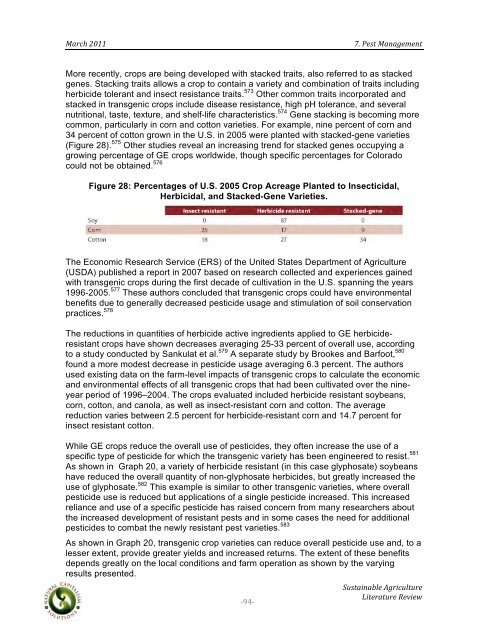Sustainable Agriculture Literature Review - Boulder County
Sustainable Agriculture Literature Review - Boulder County
Sustainable Agriculture Literature Review - Boulder County
You also want an ePaper? Increase the reach of your titles
YUMPU automatically turns print PDFs into web optimized ePapers that Google loves.
! ! !!<br />
"#$%&!'())!! !!!!!!!!!!!!!!!!!!!!!!!!!!!!!!!!!!!!!!!!!!!!!!!!!!!!!!!!!!!!!!!!@+!A142!"#5#81B152!<br />
More recently, crops are being developed with stacked traits, also referred to as stacked<br />
genes. Stacking traits allows a crop to contain a variety and combination of traits including<br />
herbicide tolerant and insect resistance traits. 573 Other common traits incorporated and<br />
stacked in transgenic crops include disease resistance, high pH tolerance, and several<br />
nutritional, taste, texture, and shelf-life characteristics. 574 Gene stacking is becoming more<br />
common, particularly in corn and cotton varieties. For example, nine percent of corn and<br />
34 percent of cotton grown in the U.S. in 2005 were planted with stacked-gene varieties<br />
(Figure 28). 575 Other studies reveal an increasing trend for stacked genes occupying a<br />
growing percentage of GE crops worldwide, though specific percentages for Colorado<br />
could not be obtained. 576<br />
!<br />
Figure 28: Percentages of U.S. 2005 Crop Acreage Planted to Insecticidal,<br />
Herbicidal, and Stacked-Gene Varieties.<br />
The Economic Research Service (ERS) of the United States Department of <strong>Agriculture</strong><br />
(USDA) published a report in 2007 based on research collected and experiences gained<br />
with transgenic crops during the first decade of cultivation in the U.S. spanning the years<br />
1996-2005. 577 These authors concluded that transgenic crops could have environmental<br />
benefits due to generally decreased pesticide usage and stimulation of soil conservation<br />
practices. 578<br />
The reductions in quantities of herbicide active ingredients applied to GE herbicideresistant<br />
crops have shown decreases averaging 25-33 percent of overall use, according<br />
to a study conducted by Sankulat et al. 579 A separate study by Brookes and Barfoot, 580<br />
found a more modest decrease in pesticide usage averaging 6.3 percent. The authors<br />
used existing data on the farm-level impacts of transgenic crops to calculate the economic<br />
and environmental effects of all transgenic crops that had been cultivated over the nineyear<br />
period of 1996–2004. The crops evaluated included herbicide resistant soybeans,<br />
corn, cotton, and canola, as well as insect-resistant corn and cotton. The average<br />
reduction varies between 2.5 percent for herbicide-resistant corn and 14.7 percent for<br />
insect resistant cotton.<br />
While GE crops reduce the overall use of pesticides, they often increase the use of a<br />
specific type of pesticide for which the transgenic variety has been engineered to resist. 581<br />
As shown in Graph 20, a variety of herbicide resistant (in this case glyphosate) soybeans<br />
have reduced the overall quantity of non-glyphosate herbicides, but greatly increased the<br />
use of glyphosate. 582 This example is similar to other transgenic varieties, where overall<br />
pesticide use is reduced but applications of a single pesticide increased. This increased<br />
reliance and use of a specific pesticide has raised concern from many researchers about<br />
the increased development of resistant pests and in some cases the need for additional<br />
pesticides to combat the newly resistant pest varieties. 583<br />
As shown in Graph 20, transgenic crop varieties can reduce overall pesticide use and, to a<br />
lesser extent, provide greater yields and increased returns. The extent of these benefits<br />
depends greatly on the local conditions and farm operation as shown by the varying<br />
results presented.<br />
"$*"<br />
!,342#.5#6/1!78$.%3/23$1!<br />
9.21$#23$1!:1;.1
















